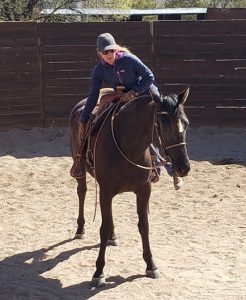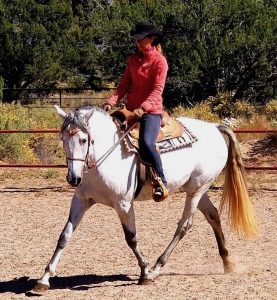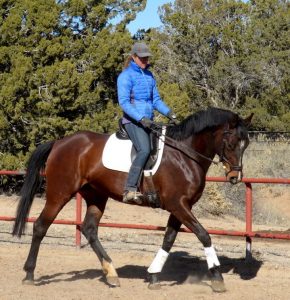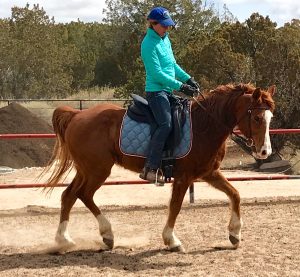 Editor’s Note: 2018 & 2019 Best Horse Practices Summit presenter Katrin Silva grew up riding dressage in Germany before moving to the United States at age 19 to learn to ride Western. She’s been riding both disciplines for the last twenty years and is a regular guest columnist. She lives in New Mexico where she works with dressage and Western clients. Visit her blog here.
Editor’s Note: 2018 & 2019 Best Horse Practices Summit presenter Katrin Silva grew up riding dressage in Germany before moving to the United States at age 19 to learn to ride Western. She’s been riding both disciplines for the last twenty years and is a regular guest columnist. She lives in New Mexico where she works with dressage and Western clients. Visit her blog here.
Buy her book, Dressage for All of Us.
Katrin Silva writes:
First, do no harm. Doctors have to take this oath before they can call themselves doctors. Horse trainers don’t have to promise anything before they hang out their shingle. If they did, it should: First, establish trust.
A new client apologized for her 12-year-old Arab cross not being further along in his training. “He’s just a trail horse!” she confided as she walked him to the arena. “He doesn’t know anything.” She made it sound like being a trail horse is something to be embarrassed about.
I offered to get on the horse first, to hear the horse’s side of the story. He stood quietly at the mounting block while I adjusted my stirrups. He took a deep breath, then walked and trotted happily forward, though he had no idea what a circle was. He had no idea how to give to the bit or bend around the rider’s leg, either, but I could steer and stop him without turning him into the fence.

Elena, relaxed and focused
Within 30 minutes, the horse began to stretch, bend, and lower his neck. The owner looked impressed. I pointed out that she deserved most of the credit. The horse trusts her, and, by extension, trusts me. This made it easy to focus on teaching him about how to carry himself in a way that would allow him to develop correct balance and the right kind of muscles. The owner then got on her horse, and we finished the lesson on a positive note, all three of us happy with where we were headed. I am looking forward to riding this horse again.
I saddled my next horse, a six-year old Warmblood mare I’ve been working with every day for several months. This mare had been started in draw reins and rushed through her early training. Her current owner bought her for a suspiciously low price last year. The mare bucked her off shortly thereafter, which is the reason she ended up in my program.
Unlike my new client’s trail horse, this talented mare can perform most movements of second level dressage. Also unlike the trail horse, she has never learned to just carry a rider on a relaxed back. Even after all the time I’ve spent with her, going on trail rides, re-starting her in the round pen, and teaching her to stretch forward and down, she remains unpredictable. There is a residual tension in her back. There are, by now, many times when she relaxes enough to let me talk to her through my seat and hands, but other times I can feel her turn into a coiled spring underneath me. Every time I think she will never buck again, she does.

A talented but troubled horse
She can’t help it. She’s like a war veteran with PTSD symptoms. I don’t blame the mare. I know she is only defending herself when she thinks I’m about to force her back into the artificially round, pulled-together frame she learned to fear as a youngster, an uncomfortable position that left her nowhere to go but up. I am doing what I can to help her, but I am not sure this horse will ever be safe to ride, or fun to ride. She has not (yet) bucked me off. With time and patience, she might still become a solid citizen. But then again, she might not. With a troubled horse, it’s hard to say.
A horse with little formal education who basically trusts people is much easier to teach than a troubled one who has lost this trust. Before I can work on anything else, I have to teach the troubled horse to trust me, first from the ground, then on his back. Before I can think about dressage movements, before I can think about moving up the training scale, the horse has to carry me without anxiety or tension. Sometimes, the horse’s trust is destroyed for good. Often, such horses will be labeled as unrideable or ill-tempered and sold or given away into an uncertain future.
- If you’re “just” a trail rider or “just” an endurance rider
- If your horse has no idea what a circle is
- If your horse has never heard of contact or connection

Lionel, endurance horse, is learning to stretch and bend
…then your horse may nonetheless be better trained than many others.
- If your horse carries you willingly
- If your horse trusts you enough to accept your presence and your weight on his back
…then you are doing something right. You have confirmed the bottom layer of the training scale. From here, progress is comparatively easy. Trust and relaxation are the bedrock of all good horsemanship.
A horse who has not learned to move freely forward with a rider on his back will never be a dependable, willing partner. Before we can worry about anything else, a horse has to carry his rider in a trusting frame of mind and body. At that point, it doesn’t matter where he carries his head and neck. It’s too early to worry about contact with the bit. Trying to make him look like a more advanced dressage horse may be tempting, especially if he’s born and bred to go up the levels. Don’t go there. Take the time to establish trust and relaxation, or you will pay for it later. Without these elements, a horse’s training becomes a house of cards, likely to collapse at the slightest distraction or bump in the road.
Another article that demonstrates why I love Katrin Sliva’s skills, knowledge and teaching style. Sure glad to have met her through the Best Horse Practices Summit several years back.
Best Practices Horse Summit continues to lead the way for those of us looking for the truth- in- practice with our horses, without undue harm. But even more than that, it helps us understand how to lead our horses with empathy and insight—the only way to truly master the art and the science behind our behavior with horses. Thanks for more inspiration Katrin. You are one of the best!
Thank you Katrin, for this reminder!!